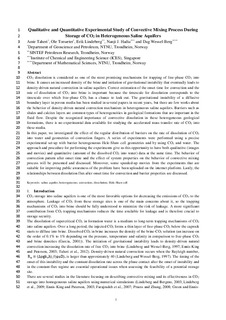| dc.contributor.author | Taheri, Amir | |
| dc.contributor.author | Torsæter, Ole | |
| dc.contributor.author | Lindeberg, Erik Gøsta Brun | |
| dc.contributor.author | Hadia, Nanji | |
| dc.contributor.author | Wessel-Berg, Dag | |
| dc.date.accessioned | 2019-05-23T15:02:24Z | |
| dc.date.available | 2019-05-23T15:02:24Z | |
| dc.date.created | 2018-04-10T10:18:41Z | |
| dc.date.issued | 2018 | |
| dc.identifier.citation | International Journal of Greenhouse Gas Control. 2018, 71 212-226. | nb_NO |
| dc.identifier.issn | 1750-5836 | |
| dc.identifier.uri | http://hdl.handle.net/11250/2598612 | |
| dc.description.abstract | CO2 dissolution is considered as one of the most promising mechanisms for trapping of free-phase CO2 into brine. It causes an increased density of the brine and initiation of gravitational instability that eventually leads to density-driven natural convection in saline aquifers. Correct estimation of the onset time for convection and the rate of dissolution of CO2 into brine is important because the timescale for dissolution corresponds to the timescale over which free-phase CO2 has a chance to leak out. The gravitational instability of a diffusive boundary layer in porous media has been studied in several papers in recent years, but there are few works about the behavior of density-driven natural convection mechanism in heterogeneous saline aquifers. Barriers such as shales and calcites layers are common types of heterogeneities in geological formations that are important in the fluid flow. Despite the recognized importance of convective dissolution in these heterogeneous geological formations, there is no experimental data available for studying the accelerated mass transfer rate of CO2 into these media. In this paper, we investigated the effect of the regular distribution of barriers on the rate of dissolution of CO2 into water and geometries of convection fingers. A series of experiments were performed using a precise experimental set-up with barrier heterogeneous Hele-Shaw cell geometries and by using CO2 and water. The approach and procedure for performing the experiments give us this opportunity to have both qualitative (images and movies) and quantitative (amount of the dissolved CO2 into water) data at the same time. The behavior of convection pattern after onset time and the effect of system properties on the behavior of convective mixing process will be presented and discussed. Moreover, some speeded-up movies from the experiments that are suitable for improving public awareness of the problem have been uploaded on the internet platform. Lastly, the relationships between dissolution flux after onset time for convection and barrier properties are discussed. | nb_NO |
| dc.language.iso | eng | nb_NO |
| dc.publisher | Elsevier | nb_NO |
| dc.rights | Attribution-NonCommercial-NoDerivatives 4.0 Internasjonal | * |
| dc.rights.uri | http://creativecommons.org/licenses/by-nc-nd/4.0/deed.no | * |
| dc.title | Qualitative and quantitative experimental study of convective mixing process during storage of CO2 in heterogeneous saline aquifers | nb_NO |
| dc.type | Journal article | nb_NO |
| dc.type | Peer reviewed | nb_NO |
| dc.description.version | acceptedVersion | nb_NO |
| dc.source.pagenumber | 212-226 | nb_NO |
| dc.source.volume | 71 | nb_NO |
| dc.source.journal | International Journal of Greenhouse Gas Control | nb_NO |
| dc.identifier.doi | 10.1016/j.ijggc.2018.02.003 | |
| dc.identifier.cristin | 1578530 | |
| dc.description.localcode | © 2018. This is the authors’ accepted and refereed manuscript to the article. Locked until 18.3.2020 due to copyright restrictions. This manuscript version is made available under the CC-BY-NC-ND 4.0 license http://creativecommons.org/licenses/by-nc-nd/4.0/ | nb_NO |
| cristin.unitcode | 194,64,90,0 | |
| cristin.unitcode | 194,63,15,0 | |
| cristin.unitname | Institutt for geovitenskap og petroleum | |
| cristin.unitname | Institutt for matematiske fag | |
| cristin.ispublished | true | |
| cristin.fulltext | postprint | |
| cristin.qualitycode | 2 | |

